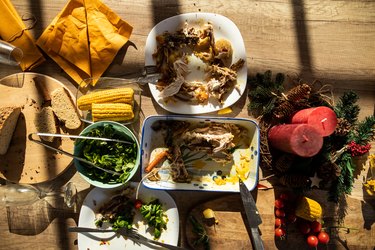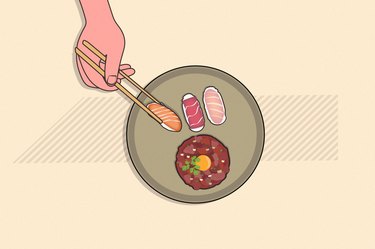
The Centers for Disease Control and Prevention (CDC) estimate that some 48 million people fall ill from foodborne pathogens annually, so it's a good idea to familiarize yourself with the telltale signs of common foodborne illnesses, plus how to prevent them.
Below, here's everything you need to know about the germs behind your last stomach bug.
Video of the Day
Video of the Day
What Are Foodborne Pathogens?
You've likely received a news alert about an E. Coli outbreak in the past. But the reality is that there are more than 250 different disease-causing bugs that can exist within our food, per the CDC.
Unlike the beneficial bacteria like lactobacilli found in some yogurts, foodborne germs can cause a slew of uncomfortable symptoms. And they aren't limited to bacteria. Foodborne pathogens can also include viruses, parasites and toxins.
How Do Pathogens Get Into Our Food?
There's more than one way germs can enter the food supply.
The water used to irrigate soil can get contaminated with unwanted germs, which are then transferred to the food that's being grown in the ground. Pathogens on farm animals' skin may make their way into meat and poultry products during slaughtering and processing. Fish can also pick up toxins when they eat smaller organisms in the sea, per the CDC.
Of course, people infected with a foodborne illness who then handle or prepare food for others without practicing proper hygiene can transfer germs to our plates too.
Food that stays in the "temperature danger zone," the range of temps at which bacteria rapidly multiply — that's about 40 to 140 degrees Fahrenheit — is also subject to pathogenic growth, per the USDA. Food that remains within this temperature range for an extended period of time (2 hours or longer) can experience a twofold increase in bacteria every 20 minutes, according to the Academy of Nutrition and Dietetics.
How Do Foodborne Illnesses Differ From Food Poisoning?
Though we typically refer to all foodborne illnesses as "food poisoning," they're actually not one in the same, per the USDA. Think of "foodborne illness" as an umbrella term — within this category are cases of infection as well as intoxication.
Foodborne infections are those that occur when we eat food that contains disease-causing bacteria. How soon we start to experience symptoms from foodborne infections can vary widely, with signs of disease sometimes taking weeks to show up.
Food intoxications, or true food poisoning, are caused by foods that contain toxins that are released by germs. In other words, it's the toxins that cause the foodborne illness, not the bacteria themselves. Unlike with infection, intoxication symptoms typically show up very soon after eating contaminated foods.
Tip
Most bacteria require certain conditions to thrive. Foods that are warm, wet or moist and either neutral or just slightly acidic are more prone to bacterial growth, per the Florida Department of Agriculture and Consumer Services. That's why cooked chicken that's been left out for a couple of hours is at much higher risk of bacterial growth than the dry rice that's been sitting in your cupboard for a year.
What Are the Most Common Types of Foodborne Illnesses?
Here are some of the most common types of foodborne illnesses in the United States, plus what you need to know about each, according to the U.S. Department of Health & Human Services.
1. Norovirus
What it is: The number one most common foodborne infection, norovirus accounts for some 685 million global cases of GI upset annually, per the CDC.
Sources: Common causes of norovirus spread include contact with infected people and surfaces, as well as taking in food or beverages that have been contaminated with the virus. Common food sources of norovirus include fresh produce, shellfish and ready-to-eat items like salads, sandwiches and cut fruit prepared by infected individuals.
Incubation range: Anywhere from 12 to 48 hours.
Symptoms: Diarrhea, vomiting, abdominal pain and nausea.
How to lower your risk: Always wash your hands well with warm water and soap, lathering for a minimum of 20 seconds. Wear gloves whenever preparing ready-to-eat food and regularly disinfect surfaces and linens possibly contaminated with the virus. If you're experiencing diarrhea or nausea and vomiting, do not prepare food for others for at least 2 days.
2. Salmonella
What it is: Best known as the reason to avoid eating raw cookie dough, salmonella can contaminate more than just your favorite brownie batter.
Sources: Animal proteins like poultry, pork, eggs and red meat as well as fruits, vegetables (especially sprouts) and nuts. Salmonella has also been found in items like pet food and treats.
Incubation range: Anywhere from 6 hours to 6 days.
Symptoms: Diarrhea, nausea, vomiting, fever and abdominal pain or cramping.
How to lower your risk: Avoid undercooked proteins like raw eggs and rare meat. Milk that hasn't been pasteurized is also a high-risk food for salmonella contamination.
3. Clostridium Perfringens
What it is: Clostridium perfringens, which are toxins produced by certain bacteria, cannot be spread from person to person.
Sources: Animal proteins like red meat or poultry or any food left in the temperature danger zone for more than 2 hours.
Incubation range: Anywhere from 6 to 24 hours.
Symptoms: Diarrhea, vomiting and abdominal pain or cramping.
How to lower your risk: Make sure high-risk foods are cooked/reheated to or kept at safe temperatures. The CDC recommends keeping hot food above 140 degrees F (and serving it within 2 hours) and cold foods below 40 degrees F (and refrigerating them within 2 hours). Leftovers should be reheated to at least 165 degrees F. Dividing big batches of food up into smaller portions can assist with swift reheating and cooling.
Tip
Most foodborne illnesses are self-limiting, meaning people infected with them typically recover without any medical intervention. People who are immunocompromised — such as pregnant, young and older people, as well as those diagnosed with conditions like cancer, HIV/AIDs and liver or kidney disease — may be at greater risk for more severe foodborne illnesses and complications.
4. Campylobacter
What it is: Also known as Campylobacteriosis, this infectious microorganism is responsible for some 1.5 million diarrheal infections in the U.S. every year, per the CDC.
Sources: Unpasteurized (aka raw) milk, poultry, shellfish and water.
Incubation range: Anywhere from 2 to 5 days.
Symptoms: Diarrhea (possibly containing blood), abdominal pain and cramping, fever and vomiting are all common reactions to campylobacter infection.
How to lower your risk: Only drink pasteurized milk and treated water that has undergone filtration and disinfection (public water systems are treated, per the CDC).
5. E. Coli
What it is: It's actually totally normal to have Escherichia Coli bacteria in your intestines, and the majority of these bugs don't induce illness, according to the CDC. But, there are specific forms, or subtypes, of E. coli that are pathogenic. Those subtypes are the ones responsible for the news-worthy recalls of items like romaine lettuce.
Sources: Undercooked animal proteins such as raw beef, unpasteurized milk and cheeses, raw fruits and vegetables and contaminated water. Accidentally taking in feces particles from infected animals or people can also spread E. coli germs.
Incubation range: Anywhere from 1 to 10 days.
Symptoms: Diarrhea (possibly containing blood), abdominal pain and vomiting. Severe E. coli infections can lead to a condition called hemolytic uremic syndrome (HUS), which is characterized by a reduction in urination, dark-colored urine and loss of coloring in the face. Contact your doctor immediately if you are experiencing any of the hallmark symptoms of HUS.
How to lower your risk: Do not eat high-risk foods like raw or undercooked beef and unpasteurized milk, juices or cheeses. Foods like ground beef should always be cooked to 160 degrees F. And be diligent about washing your hands thoroughly whenever you're preparing food and/or dealing with feces from animals or babies.
6. Listeria
What it is: Listeria is among the six most common foodborne infections in the U.S.
Sources: Unpasteurized milk and cheeses, raw fruits and vegetables, processed animal proteins like deli meats and hot dogs and smoked seafood products such as smoked salmon.
Incubation range: Anywhere from 7 to 70 days.
Symptoms: Diarrhea and fever are the most common symptoms of listeria infection, however, the bacteria can cause systemic symptoms if they travel beyond the GI tract. This condition, called invasive listeriosis, can cause fatigue, muscle stiffness, confusion and balance challenges.
How to lower your risk: High-risk individuals including pregnant, older and other immunocompromised people should avoid eating foods prone to listeria contamination, including processed meats, refrigerated smoked seafood products (fish that is canned or cooked into a casserole are OK), raw sprouts and unpasteurized milks and cheeses.
7. Staphylococcus Aureus
What it is: Though not as common as the germs described above, Staphylococcus aureus is still a concern.
Sources: Staph often lives on the skin, so food that's been handled or prepared by anyone with staph is a possible source of contamination. Items that don't get heated post-preparation, such as deli meats, sandwiches, salads and sweets like pastries are also high-risk sources of staph.
Incubation range: Staph aureus bacteria produce disease-causing toxins, so symptoms show up quickly within 30 minutes to 8 hours of intake, per the CDC.
Symptoms: Sudden nausea and vomiting, diarrhea and abdominal pain or cramping.
How to lower your risk: Always keep foods at the safe temperatures highlighted above. Avoid preparing or handling food if you're experiencing gastrointestinal symptoms such as diarrhea, nausea or vomiting. And, as always, wash your hands well and often.
- Centers for Disease Control and Prevention: "Foodborne Germs and Illnesses"
- Centers for Disease Control and Prevention: "How Food Gets Contaminated – The Food Production Chain"
- Academy of Nutrition and Dietetics: "The Temperature Danger Zone"
- U.S. Department of Agriculture: "What is the Difference Between Foodborne Illness and Food Poisoning?"
- Florida Department of Agriculture and Consumer Services: "What Conditions Encourage Bacteria to Grow?"
- Centers for Disease Control and Prevention: "Norovirus Worldwide"
- Centers for Disease Control and Prevention: "Campylobacter (Campylobacteriosis)"
- Centers for Disease Control and Prevention: "Water Treatment"
- Centers for Disease Control and Prevention: "E. coli (Escherichia coli)"
- Centers for Disease Control and Prevention: "Staphylococcal (Staph) Food Poisoning"
- Food Safety: "Bacteria and Viruses"


